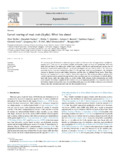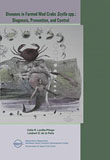Mud crab hatchery and grow-out status in the Philippines
- Global styles
- MLA
- Vancouver
- Elsevier - Harvard
- APA
- Help

View/
Date
2004Author
Page views
3,409ASFA keyword
AGROVOC keyword
Taxonomic term
Metadata
Show full item record
Share
Abstract
Interest in mud crab aquaculture is increasing throughout the Philippines because of its demand both in local and export markets. Mud crab culture started as low-density polyculture with fish or shrimp using wild crab juveniles and developed to monoculture in ponds and cages. Recently, an integrated mangrove-crab culture system has been practiced. Mud crab species commonly cultured are Scylla serrata, S. tranquebarica, and S. olivacea.
The yearly increase in production from 1996 to 2000 (Table 1) may indicate a corresponding increase in the seed collection activity due to greater demand of seeds for stocking. According to many gatherers in the country, there has been a declining volume of all size-classes, from juveniles to adult crabs, gathered from the wild over the last decade. Hence, the development of a commercially viable hatchery technology can play an important role in promoting sustainable crab aquaculture and fisheries management.
Suggested Citation
Quinitio, E. T. (2004). Mud crab hatchery and grow-out status in the Philippines. In G. Allan & D. Fielder (Eds.), Mud crab aquaculture in Australia and Southeast Asia. Proceedings of the ACIAR Crab Aquaculture Scoping Study and Workshop 28–29 April 2003, Joondooburri Conference Centre, Bribie Island (pp. 53-56). Canberra, Australia: Australian Centre for International Agricultural Research.
Type
Conference paperISBN
1863203990Series
ACIAR Working Paper;No. 54Collections
- Conference Proceedings [299]
Related items
Showing items related by title, author, creator and subject.
-
Larval rearing of mud crab (Scylla): What lies ahead
Waiho, Khor; Fazhan, Hanafiah; Quinitio, Emilia T. ; Baylon, Juliana C.; Fujaya, Yushinta; Azmie, Ghazali; Wu, Qingyang; Shi, Xi; Ikhwanuddin, Mhd; Ma, Hongyu (Elsevier, 2018)
The increasing global demand for mud crabs (genus Scylla) and threats to the wild populations highlight the urgency of fully rearing them in captivity. Despite considerable progress in mud crab production, most crab farms ...
; Baylon, Juliana C.; Fujaya, Yushinta; Azmie, Ghazali; Wu, Qingyang; Shi, Xi; Ikhwanuddin, Mhd; Ma, Hongyu (Elsevier, 2018)
The increasing global demand for mud crabs (genus Scylla) and threats to the wild populations highlight the urgency of fully rearing them in captivity. Despite considerable progress in mud crab production, most crab farms ... -
Diseases in farmed mud crabs Scylla spp.: Diagnosis, prevention, and control.
Lavilla-Pitogo, Celia R.; de la Peña, Leobert D. (Aquaculture Dept., Southeast Asian Fisheries Development Center, 2004-12)Aquaculture production has suffered many set-backs due to the occurrence of diseases. Many of the diseases are caused by infectious organisms that are difficult to detect and need sophisticated instruments for diagnosis, ... -
Mud crab pond and pen culture
Rodriguez, Eduard M. (University of the Philippines Aquaculture Society, Inc, 2001)




